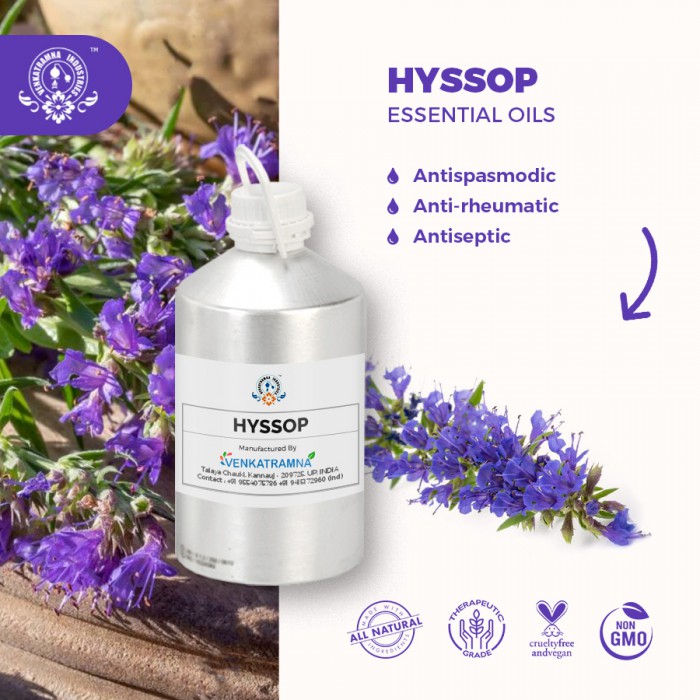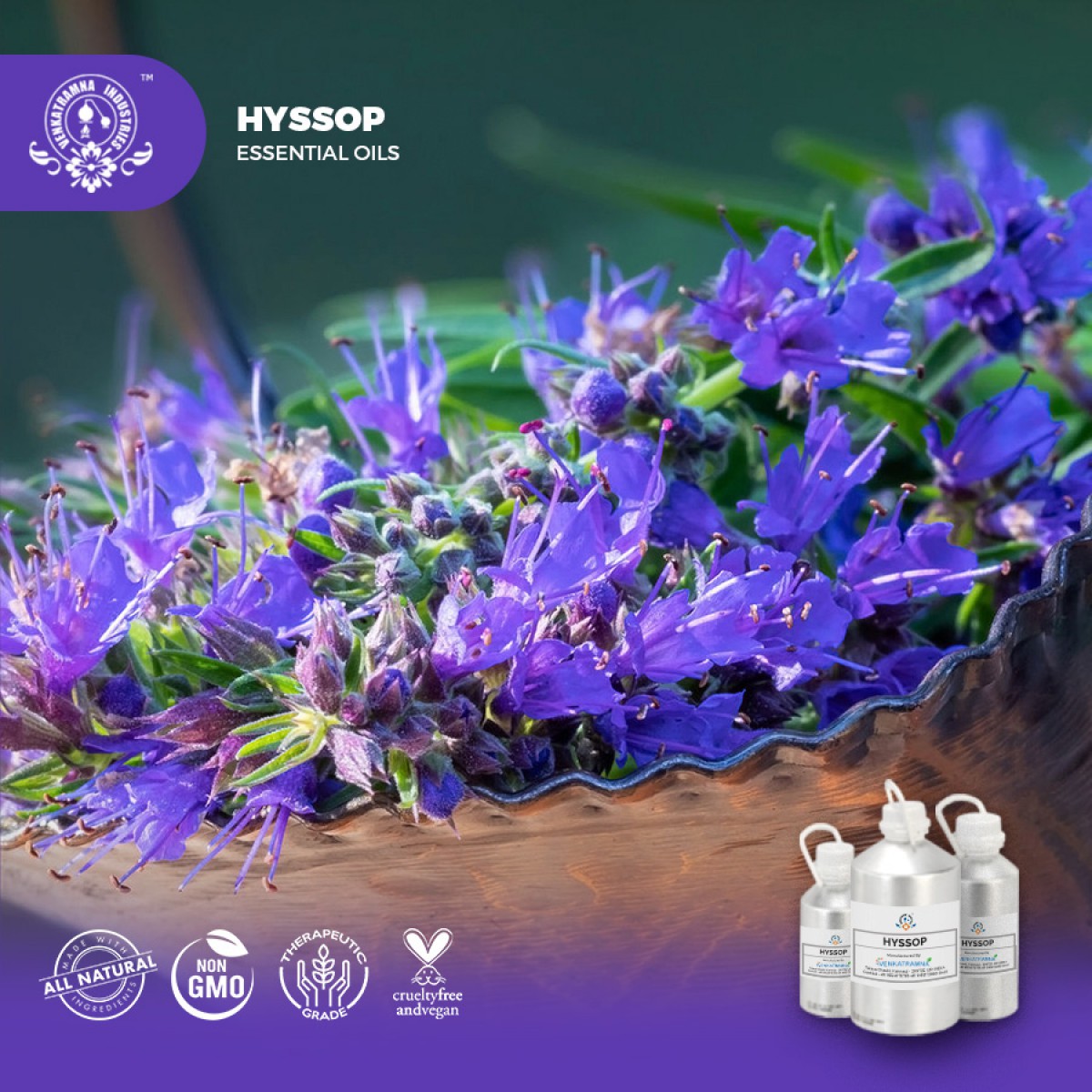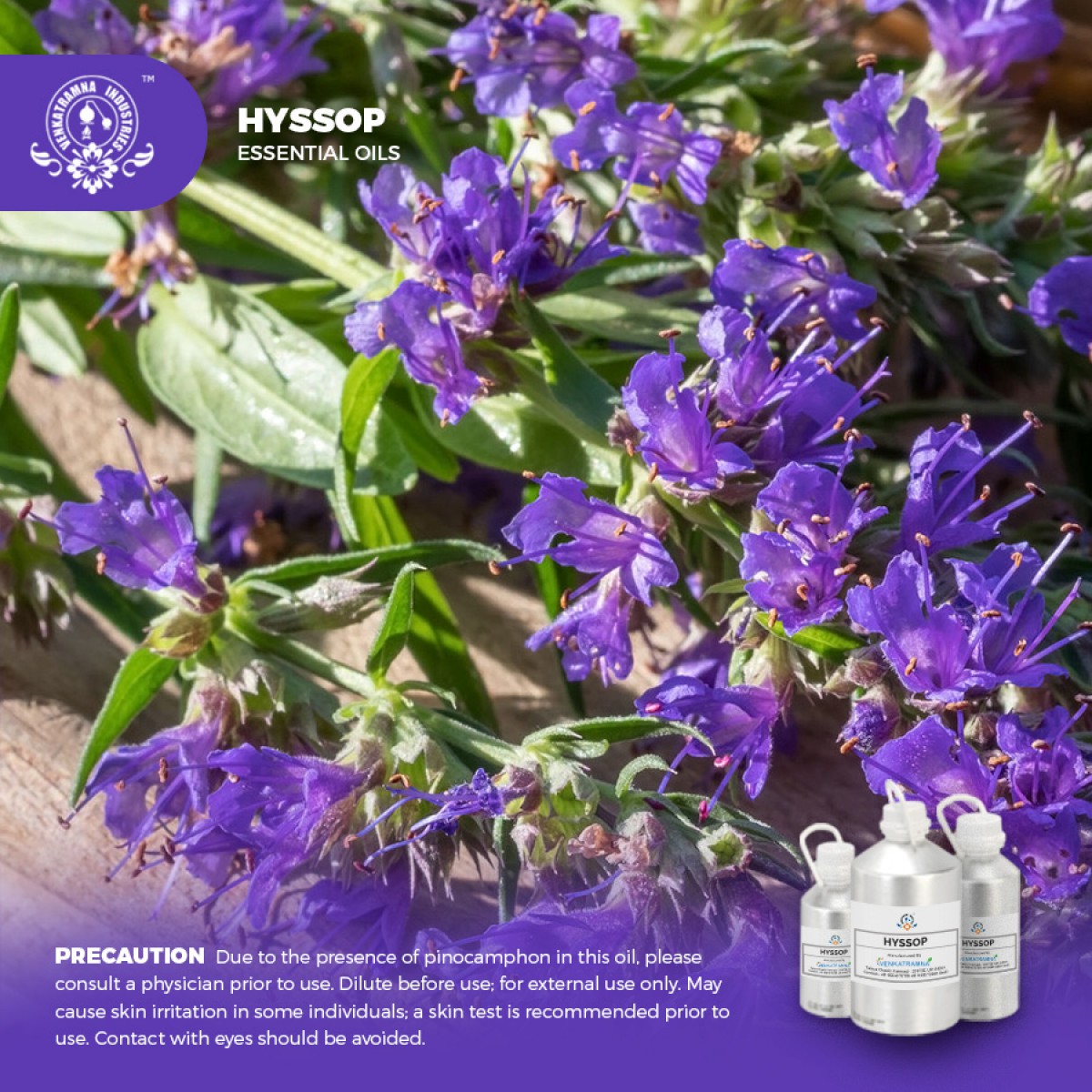Botanical Name: Hyssopus officinalis L Common name: hyssop Plant f Read More
|
Botanical Name: |
Hyssopus
officinalis L |
|
Common name: |
hyssop |
|
Plant family: |
Lamiaceae |
|
Genus: |
Hyssopus |
|
Appearance/Color: |
Thin liquid pale
yellow to yellow liquid |
|
Odor: |
Medium aroma with
pleasing medicinal scent |
|
Blends With: |
Eucalyptus,
ravensara, niaouli, cajeput and myrtle |
|
Origin: |
Slovenia |
|
Source: |
Leaves and
flowers |
|
Method of
Extraction: |
Steam Distillation |
Hyssopus
officinalis L is
a perennial plant, native to the Mediterranean region and was considered a holy
plant in biblical times. During the time of the Romans, this herb was used
against the plague, as a disinfectant and for treatment of minor infections. The
plant grows up to 2 feet high and has a “hairy” stem with small pointy leaves
and blue, purple or white flowers.
The mild and gentle Hyssop essential oil is extracted by steam distillation of leaves and flowers of Hyssopus officinalis L. flowers look similar to lavender and are staple folk medicine in European countries and Slovenia.
DISCLAIMER
The complete range of conditions
or methods of use are beyond our control therefore we do not assume any
responsibility and expressly disclaim any liability for any use of this
product. Information contained herein is believed to be true and accurate however,
all statements or suggestions are made without warranty, expressed or implied,
regarding accuracy of the information, the hazards connected with the use of
the material or the results to be obtained from the use thereof. Compliance
with all applicable federal, state, and local laws and local regulations
remains the responsibility of the user.
The FDA has not evaluated the
statements on this website. No claims are made by Venkatramna Industries as to
the medicinal value of any products from vriaroma.com or by us. The information
presented here is for educating our customers about the traditional uses of
essential oils and is not intended to diagnose, treat, cure, or prevent any
disease. You are responsible for understanding the safe application of these products.
If you have any questions, please call or email us for further information.
As per NAHA guidelines, New Directions Aromatics
(NDA) does not recommend the ingestion of essential oils. It is imperative to
consult a medical practitioner before using Essential Oils for therapeutic
purposes. Pregnant and nursing women and those taking prescription drugs are
especially advised not to use this product without the medical advice of a
physician. The oil should always be stored in an area that is inaccessible to
children, especially those under the age of 7.
Hyssop Essential Oil is a
beautiful essential oil to work with for respiratory issues and can also be
helpful for digestion and muscular and joint pain. It is known as strongest
antiviral essential oils.
In traditional medicine, Hyssop
Essential Oil is used to stimulate
several body systems. It helps stimulate your digestive system for better
metabolism and nutrient absorption. It is used as stimulant to nervous,
endocrine, circulatory and excretory systems.
Hyssop Essential Oil in Pharma
Hyssop
Essential Oil regulates
blood pressure and calms down anxiety and hysteria. When applied on
wounds, it can help them from becoming infected. The essential oil can also
help wounds, cuts and bruises heal faster. Hyssop Essential Oil helps relieve pain and fatigue. It can also be used for
menstrual pain. This herbal oil may help lower body temperature and fever.
Essence
of Hyssop Essential Oil
It
is often used on skin problems, such as insect bites, rashes, boils and even
(chicken) pox. It may even be used on scars to make them disappear quicker.
Hyssop
Essential Oil has
wide range of applications in aromatherapy to treat problems associated with respiratory
and digestive systems. Hyssop Essential Oil brings relief from arthritic pain, sores, bruises,
toothaches and ear pain by external application.
COMMON USAGE
·
Coughs
·
Colds
·
Cicatrisant
·
Influenza
·
Bronchitis,
Asthma, Bronchial Infections
·
Antiseptic
properties for Bruises, Wounds
·
Arthritis
·
Rheumatism
·
Muscular
Aches and Pains
·
Digestive
Problems
·
Antispasmodic
Ingredients:
|
S.No |
Key Constituents |
Strength (%) |
|
1 |
pinocamphone |
31.2-42.7 |
|
2 |
Isopinocamphone |
30.9-39.2 |
|
3 |
B-Pinene |
4.0-8.8 |
|
4 |
Myrtenyl methyl ether |
0-3.9 |
|
5 |
Myrtenol |
0.4-2.1 |
|
6 |
Sabinene |
1.3-1.7 |
|
7 |
Mercene |
0.7-1.2 |
|
8 |
Terpineol |
0-1.0 |
|
9 |
Methyl eugenol |
0-0.5 |
|
10 |
B thujone |
0-0.3 |
|
11 |
A thujone |
0-0.1 |
TOXICOLOGICAL INFORMATION
Safety Summary
·
Hazardous: neurotoxicity, may contain carcinogen
methyl eugenol
·
Contraindications: pregnancy, breast feeding,
children under 2years
Organ Specific Effects
·
Adverse skin reaction: undiluted Hyssop
essential oil was found non irritating to mouse, pig, rabbit. Tested 4% on 25
volunteers and was found non-irritating and non-sensitizing.
Systemic Effects
·
Acute toxicity: Eugenyl methyl ether (methyl eugenol)
(CAS: 93-15-2)
Oral
route: LD50 = 810 mg/kg.
·
Respiratory and skin sensitization: may cause
allergy by skin contact. May be fatal if swallowed and enters airways.
Aspiration toxicity include severe acute effects like chemical pneumonia, to
pulmonary injury and death.
·
Carcinogenicity: Methyl
eugenol is a rodent carcinogen when exposed to high quantities.
·
Germ cell mutagenicity: no data available
·
Reproductive toxicity: no data available
·
STOT single exposure: no data available
·
STOT repeated exposure: no data available
·
Phototoxicity: no data available
ECOLOGICAL
INFORMATION
·
Aquatic Toxicity: toxic to aquatic life with long lasting
effects
·
Bioaccumulation: No data available
·
Mobility in soil: No data available
·
Persistence and degradability: No data available
·
PBT and vPvB assessment: No data available
·
Other adverse effects: Do not allow it to enter
into water systems and marine environment.





 MSDS-hyssop.pdf
MSDS-hyssop.pdf




